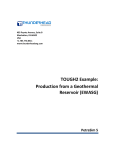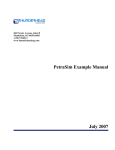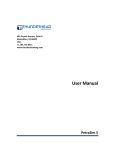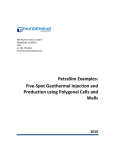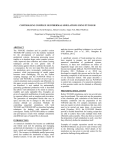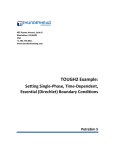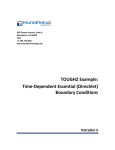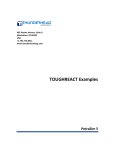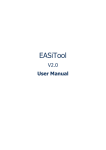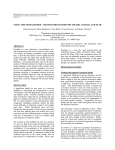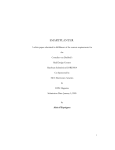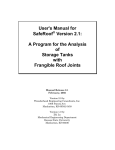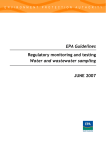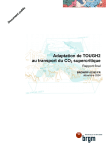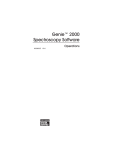Download TOUGH2/T2VOC Examples - Thunderhead Engineering
Transcript
403 Poyntz Avenue, Suite B Manhattan, KS 66502 USA +1.785.770.8511 www.thunderheadeng.com TOUGH2/T2VOC Examples PetraSim 5 TOUGH2/T2VOC Examples Table of Contents Disclaimer....................................................................................................................................... viii Acknowledgements........................................................................................................................... ix 1. Five-Spot Geothermal Injection and Production ............................................................................1 Create a New Model ................................................................................................................................. 1 Edit Layers ................................................................................................................................................. 1 Create Mesh .............................................................................................................................................. 2 Edit Global Properties ............................................................................................................................... 2 Edit Materials ............................................................................................................................................ 2 Initial Conditions ....................................................................................................................................... 3 Edit Injection and Production Cells ........................................................................................................... 3 Edit Solution Controls ............................................................................................................................... 4 Edit Output Controls ................................................................................................................................. 4 Save and Run............................................................................................................................................. 4 View 3D Results......................................................................................................................................... 5 View Time History Plots ............................................................................................................................ 6 2. Production from a Geothermal Reservoir (EWASG) .......................................................................8 Description ................................................................................................................................................ 8 Create an EWASG Model .......................................................................................................................... 8 Specify the Solution Mesh ........................................................................................................................ 8 Specify Z Divisions ................................................................................................................................. 8 Create the Mesh ................................................................................................................................... 9 Global Properties ...................................................................................................................................... 9 Material Properties ................................................................................................................................. 10 Initial Conditions ..................................................................................................................................... 11 Define Reservoir Production ................................................................................................................... 11 Solution Controls..................................................................................................................................... 12 Output Controls ...................................................................................................................................... 12 Save and Run........................................................................................................................................... 12 View 3D Results....................................................................................................................................... 13 View Cell History Plots ............................................................................................................................ 14 Line Plots ................................................................................................................................................. 15 3. 2D Steam Replacement (T2VOC)................................................................................................. 17 Description .............................................................................................................................................. 17 Create a T2VOC Model............................................................................................................................ 17 Specify the Solution Mesh ...................................................................................................................... 18 Specify Z Divisions ............................................................................................................................... 18 Create the Mesh ................................................................................................................................. 18 Global Properties .................................................................................................................................... 19 Simulation Name..................................................................................................................................... 19 EOS Data.................................................................................................................................................. 19 Material Properties ................................................................................................................................. 20 Initial Conditions ..................................................................................................................................... 21 Boundary Conditions............................................................................................................................... 22 Solution Controls..................................................................................................................................... 23 Output Controls ...................................................................................................................................... 23 iv Save and Run........................................................................................................................................... 23 View 3D Results....................................................................................................................................... 24 References....................................................................................................................................... 26 v Figures Figure 1.1: Diagram of reservoir for Five-Spot Injection .............................................................................. 1 Figure 1.2: The Running TOUGH2 dialog shows a graph of time step size. .................................................. 5 Figure 1.3: Temperature contours at end of solution .................................................................................. 6 Figure 1.4: Temperature history of injection cell. ........................................................................................ 7 Figure 2.1: The resulting model .................................................................................................................... 9 Figure 2.2: The cell to be selected .............................................................................................................. 12 Figure 2.3: 3D representation of the saturation of gas .............................................................................. 14 Figure 2.4: The cell history plot for gas saturation in the production cell .................................................. 15 Figure 2.5: Line plot of pressure ................................................................................................................. 16 Figure 2.6: Results for comparison with TOUGH2 manual ......................................................................... 16 Figure 3.1: Example Problem Overview ...................................................................................................... 17 Figure 3.2: The Model Boundary ................................................................................................................ 18 Figure 3.3: T2VOC Simulation Parameters.................................................................................................. 20 Figure 3.4: Finding a Cell in the 3D View .................................................................................................... 22 Figure 3.5: Running T2VOC ......................................................................................................................... 24 Figure 3.6: T2VOC 3D Results...................................................................................................................... 25 vi List of Tables Table 2.1: Model boundary dimensions ....................................................................................................... 8 Table 3.1: Model boundary dimensions ..................................................................................................... 17 Table 3.2: Chlorobenzene Ex 1 (CHEMP.4) ................................................................................................. 19 Table 3.3: Chlorobenzene Ex 1 (CHEMP.6) ................................................................................................. 20 Table 3.4: Chlorobenzene Ex 1 (CHEMP.7) ................................................................................................. 20 vii Disclaimer Thunderhead Engineering makes no warranty, expressed or implied, to users of PetraSim, and accepts no responsibility for its use. Users of PetraSim assume sole responsibility under Federal law for determining the appropriateness of its use in any particular application; for any conclusions drawn from the results of its use; and for any actions taken or not taken as a result of analyses performed using these tools. Users are warned that PetraSim is intended for use only by those competent in the field of multi-phase, multi-component fluid flow in porous and fractured media. PetraSim is intended only to supplement the informed judgment of the qualified user. The software package is a computer model that may or may not have predictive capability when applied to a specific set of factual circumstances. Lack of accurate predictions by the model could lead to erroneous conclusions. All results should be evaluated by an informed user. Throughout this document, the mention of computer hardware or commercial software does not constitute endorsement by Thunderhead Engineering, nor does it indicate that the products are necessarily those best suited for the intended purpose. viii Acknowledgements We thank Karsten Pruess, Tianfu Xu, George Moridis, Michael Kowalsky, Curt Oldenburg, and Stefan Finsterle in the Earth Sciences Division of Lawrence Berkeley National Laboratory for their gracious responses to our many questions. We also thank Ron Falta at Clemson University and Alfredo Battistelli at Aquater S.p.A., Italy, for their help with T2VOC and TMVOC. Without TOUGH2, T2VOC, TOUGHREACT, and TOUGH-Fx/HYDRATE, PetraSim would not exist. In preparing this manual, we have liberally used descriptions from the user manuals for the TOUGH family of codes. Links to download the TOUGH manuals are given at http://www.petrasim.com. More information about the TOUGH family of codes can be found at: http://www-esd.lbl.gov/TOUGH2/. Printed copies of the user manuals may be obtained from Karsten Pruess at <[email protected]>. The original development of PetraSim was funded by a Small Business Innovative Research grant from the U.S. Department of Energy. Additional funding was provided by a private consortium for the TOUGHREACT version and by the U.S. Department of Energy NETL for the TOUGH-Fx/HYDRATE version. We most sincerely thank our users for their feedback and support. ix 1. Five-Spot Geothermal Injection and Production This example is Problem 4 - Five Spot Geothermal Production and Injection (EOS1, EOS2) described in the TOUGH2 User's Manual (1). This example simulates a five-spot pattern of injection and production from a geothermal reservoir. Only one quarter of the reservoir is included, since the solution is symmetric, as shown in Figure 1.1. The mesh uses cells of uniform 50 m x 50 m size. Figure 1.1: Diagram of reservoir for Five-Spot Injection We will solve this example using a porous media assumption for the formation. Create a New Model This example will use EOS1, the equation of state module that models multi-phase water and tracer. The dimensions of the model will be 500x500x305 meters. This information can be entered using the New dialog. To create the model: 1. 2. 3. 4. 5. 6. 7. On the File menu, click New In the Simulator Mode list, select TOUGH2 In the Equation of State (EOS) list, select EOS1 In the X Max box, type 500 In the Y Max box, type 500 In the Z Max box, type 305 Click OK to close the dialog and create the model Edit Layers Before creating the mesh, we must first define the model layers. Layers in PetraSim define depth-based boundaries that can provide a convenient way to manage multiple rock layers. When the mesh is generated, the layer boundary will become the boundary between cells and each layer can be divided into an arbitrary number of internal divisions – these internal divisions will also become cell boundaries. 1 By default, the model is created with a single layer. Because this example contains only a single cell in the Z-direction, the layer must be edited to contain only a single cell. To set the default layer to use a single vertical cell: 1. 2. 3. 4. In the Tree View, expand the Layers node and click Default On the Edit menu, click Properties... In the Cells box, type 1 Click OK to save changes to the default layer Create Mesh To create a 10 x 10 regular mesh: 1. 2. 3. 1. On the Model menu, click Create Mesh In the X Cells box, type 10 In the Y Cells box, type 10 Click OK to create the mesh Edit Global Properties Global properties apply to the entire model. In this example, the only item to change is the analysis name. To set the simulation name: 1. On the Properties menu, click Global Properties 2. In the Name box, type Five Spot Production and Injection 3. Click OK Edit Materials This simulation will require only one material. To specify material properties: 1. 2. 3. 4. 5. On the Properties menu, click Edit Materials... In the Name box, type POMED In the Density box, type 2650.0 In the Porosity box, type 0.01 In all three Permeability boxes (X, Y, and Z), type 6e-15 For this simulation we will define relative permeability using Corey's Curves. To specify the relative permeability for this material: 1. Click Additional Material Data... 2. In the Relative Permeability list, click Corey's Curves 3. Click OK Click OK to save changes and exit the Edit Materials dialog. 2 Initial Conditions When specifying parameters such as initial conditions, PetraSim uses a tiered system that allows cells to inherit values from the containing region, regions from the containing layer, and layers from the global defaults. Once we set the default initial conditions, these values will be used by all cells except those where we have explicitly set values. Correct specification of initial conditions is essential for simulation convergence. The initial conditions must be physically meaningful. Often this requires an initial state analysis in which a model is run to obtain initial equilibrium conditions before the analysis of interest (geothermal production, VOC spill, etc.) is run. However, in 2D models with no pressure gradient (such as this) this process is simplified somewhat. To set the global initial conditions: 1. 2. 3. 4. 5. On the Properties menu, click Initial Conditions... In the EOS1 list, select Two-Phase (T, Sg) In the Temperature box, type 300 In the Gas Saturation box, type 0.01 Click OK to save changes and exit the dialog Selecting a two-phase initial state with very little gas saturation is an appropriate simplification for this geothermal analysis. Since we have only one element in the vertical direction, we have selected a temperature of 300 °C as a typical for this reservoir. The pressure will be calculated by the equation of state to correspond to the small gas saturation. Having all cells in a two-phase state will also reduce the number of state transitions (two-phase to single-phase or single-phase to two-phase) that make convergence more difficult. Edit Injection and Production Cells The total injection/production from each five spot pattern is 30 kg/sec. Since we are using quarter symmetry, the production and injection mass flow rates will be 7.5 kg/sec. In this example we edit specific cells to specify injection and production parameters. When editing individual cells, it is sometimes convenient to use the top view. To switch to the top view: in the View menu, click Top View. To define the injection cell: 1. 2. 3. 4. 5. 6. Right-click the lower left cell (ID=1), in the popup menu click Edit Cells... In the Cell Name box, type Injection Click the Sources/Sinks tab Under Injection, select the Water/Steam check box In the Rate box, type 7.5 In the Enthalpy box, type 50000 3 7. Click the Print Options tab 8. Click to select all time dependent output check boxes 9. Click OK to save changes and close the dialog To define the production cell: 1. 2. 3. 4. 5. 6. 7. 8. Right-click the upper right cell (ID=100), in the popup menu click Edit Cells... In the Cell Name box, type Production Click the Sources/Sinks tab Under Production, select the Mass Out check box In the Rate box, type 7.5 Click the Print Options tab Click to select both time dependent output check boxes Click OK to save changes and close the dialog The injection and production cells now appear in the tree at the left under the Named/Print Cells heading. Any cell that has been selected for time dependent output or explicitly named will appear in this list. Edit Solution Controls Parameters relating to the solver and time stepping can be found in the Solution Controls dialog. To specify the simulation end time: 1. On the Analysis menu, click Solution Controls 2. In the End Time list, click User Defined and type 36.5 years 3. Click OK Edit Output Controls By default, the simulation will print output every 100 time steps. For this simulation, we will specify output every 5 time steps. To specify the output frequency: 1. On the Analysis menu, click Output Controls 2. In the Print and Plot Every # Steps box, type 5 3. Click OK Save and Run The input is complete and you can run the simulation. The simulator will generate numerous output files (e.g. FOFT, mesh.csv, etc.). Since these files have the same name for every simulation, it is usually a good idea to create a folder specifically for a particular model. To save your model: 4 1. On the File menu, click Save 2. Select a location, then click Save To run the simulation: 1. On the Analysis menu, click Run TOUGH2 You should see a graph showing the increase in time step size as the simulation converges. If there are any problems, you can view the log. Output that has been identified as errors will appear in red. Figure 1.2: The Running TOUGH2 dialog shows a graph of time step size. The Simulation Complete dialog will notify you when the end time has been reached. Click OK to dismiss the notification and click Close to exit the Running TOUGH2 dialog. View 3D Results To open the 3D Results dialog: 1. On the Results menu, click 3D Results By default, the display will show isosurfaces corresponding to pressure for the first output step. To show temperature isosurfaces for the last time step: 1. In the Scalar list, click T 2. In the Time(s) list, click the last entry (t = 1.152E09) To show scalar data on a slice plane: 5 1. 2. 3. 4. Click Slice Planes... In the Axis list, click Z In the Coord box, type 100 Click Close To remove isosurfaces and show only slice data: 1. Click to clear the Show Isosurfaces check box The resulting visualization is shown below. Note the temperature drop at the production well. This is a result of specifying a production flow rate, which results in a lower pressure than would physically occur in a real well. This will be discussed further in the next example. Figure 1.3: Temperature contours at end of solution When finished, you can close the 3D Results dialog. View Time History Plots To view time history plots: 1. On the PetraSim Results menu, click Cell History Plots 2. In the Variable list, click T (deg C) 3. In the Cell Name list, click Injection The resulting plot is shown below. 6 Figure 1.4: Temperature history of injection cell. When finished, you can close the Cell History dialog. 7 2. Production from a Geothermal Reservoir (EWASG) Description This example is Problem 12 - Production from a Geothermal Reservoir with Hypersaline Brine and CO2 (EWASG) described in the TOUGH2 User's Manual (1). This problem examines production from a hypothetical geothermal reservoir with high salinity and CO2. Fluid withdrawal causes pressure to drop near the production well. Boiling of reservoir fluid gives rise to dilution of CO2 in the gas phase and to increased concentrations of dissolved NaCl, which begins to precipitate when the aqueous solubility limit is reached. As the boiling front receded from the well, solid precipitate fills approximately 10% of the original void space, causing permeability to decline to approximately 28% of its original value. The mesh uses a 1D radial geometry. Create an EWASG Model We will first create a new model using the EWASG EOS. From the File menu, select New… to open the New Model dialog. 1. For the Simulator Mode, choose TOUGH2. 2. For the Equation of State (EOS), choose EWASG. 3. For the Model Bounds, enter the values from Table 2.1. Table 2.1: Model boundary dimensions Axis X Y Z Min (m) 5.0 0.0 -500.0 Max (m) 1000.0 1.0 0.0 Click OK to close the New Model dialog and create the model. Specify the Solution Mesh The solution mesh must be specified in two steps. First the Z divisions must be specified per layer. Then the mesh can be created using the Create Mesh dialog. Specify Z Divisions We must first specify one Z division for the default layer. To do so, we will open the Edit Layers dialog. On the Model menu, select Edit Layers…. 1. 2. 3. 4. In the layers list in the left-hand pane, select the Default layer. In the right-hand pane, select Regular for Dz. In the Cells box, type 1. In the Factor box, type 1.0. 8 Click OK to apply the changes and close the Edit Layers dialog. Create the Mesh We will now create the radial solution mesh using the Create Mesh dialog. To open the dialog, on the Model menu, select Create Mesh…. 1. 2. 3. 4. For the Mesh Type, select Radial. For the Divisions, select Regular. In the Radial Cells box, type 100. In the Factor box, type 1.03705. Click OK to create the mesh. We have selected Radial Mesh as the mesh type. This means that a 2D cylindrical RZ mesh will be created in which X corresponds to cylindrical R, Z corresponds to cylindrical Z, and the Y coordinate corresponds to cylindrical Theta (which is not used). 100 cells extend in the R direction, with an X Factor of 1.03705. This means that each cell is 1.03705 times the size of the previous cell in the R direction. These were chosen to give a first cell length of 2.0 m, which is the value used in the TOUGH2 example. See the PetraSim User Manual for instructions on how to calculate the appropriate factor. The resulting mesh is displayed in Figure 2.1. Click the Front View button the model until the front is visible. on the toolbar or rotate Figure 2.1: The resulting model Global Properties Global properties are those properties that apply to the entire model. We will make changes to some of the EOS options, including activating molecular diffusion. To edit global properties, you use the Global Properties dialog. 9 On the Properties menu, click Global Properties… (or click 1. 2. 3. 4. 5. 6. 7. 8. 9. 10. 11. 12. 13. on the main toolbar). In the Global Properties dialog, select the Analysis tab. In the Name box, type Geothermal Production, Brine and CO2. In the Global Properties dialog, select the EOS tab. Select Non-Isothermal. In the Type of NCG list, select CO2. For Dependence of Permeability on Pore Space, select Tubes in Series. In the phi box, type 0.8. In the G box, type 0.8. In the Property Dependence on Salinity list, select Full Dependence. In the Brine Enthalpy Correction list, select Michaelides. Select the Include Vapor Pressure Lowering checkbox. Do NOT select Molecular Diffusion. Click OK to close the Global Properties dialog. Material Properties To specify the material properties, use the Material Data dialog. 1. 2. 3. 4. 5. 6. 7. 8. On the Properties menu, click Edit Materials… (or click on the toolbar). In the Name box, type POMED. In the Density box, type 2600.0. In the Porosity box, type 0.05. In all three Permeability boxes (X, Y, and Z), type 50e-15. In the Wet Heat Conductivity box, type 2.0. In the Specific Heat box, type 1000.0. Click Apply to save the changes. In addition to the physical rock parameters, we also need to specify the relative permeability and capillary pressure functions for this material. These options can be found in the Additional Material Data dialog. To open this dialog, click the Additional Material Data… button. To specify the relative permeability function 1. 2. 3. 4. Select the Relative Perm tab. In the Relative Permeability list, select Corey’s Curves. In the Slr box, type 0.3. In the Sgr box, type 0.05. The default capillary pressure (none) is correct for this example. Click OK to exit the Advanced Material Data dialog. Click OK again to save your settings and exit the Material Data dialog. 10 Initial Conditions The initial state of each cell in the model must be defined. To specify global initial conditions that will be used as the default for all cells in the model, on the Properties menu, click Initial Conditions... (or click on the toolbar). To set the initial conditions 1. 2. 3. 4. 5. Select the Two Fluid Phases (P, Xsm, Sg, T) state option. In the Pressure box, type 6.0E6. In the Temperature box, type 275.55. In the Gas Saturation box, type 0.45. In the Salt Mass Fraction box, type 0.3. Click OK to close the Default Initial Conditions dialog. Define Reservoir Production In this model, fluid is produced from the inner cell. 1. In the 3D View, click the Front View button on the toolbar or rotate the model until the front is visible. 2. Use the Zoom Box tool to zoom in on the left side of the model until the left-most cell is visible. 3. Using the 3D Orbit Navigation tool , right click the left-most cell and from the context menu, select Edit Cells... as shown in Figure 2.2. 4. In the Cell Name box, type Production. 5. Click the Sources/Sinks tab. 6. In the Production section, select the Mass Out check box. 7. In the Rate box, type 65. 8. Click the Print Options tab. 9. Select the Print Time Dependent Flow and Generation (BC) Data. 10. Click OK to close the Edit Cell Data dialog. 11 Figure 2.2: The cell to be selected Solution Controls We will now define the solution control options. 1. 2. 3. 4. 5. 6. On the Analysis menu, click Solution Controls… (or click on the main toolbar). In the End Time box, type 2.0E6 (approximately 23 days). In the Time Step list, ensure that Single Value is selected. In the Time Step box, type 1000. This is the initial time step. Select Enable Automatic Time Step Adjustment. Click OK to exit the Solution Controls dialog. Output Controls By default, the simulation will print output every 100 time steps. We can increase the frequency of the output in the Output Controls dialog. 1. 2. 3. 4. 5. 6. On the Analysis menu, click Output Controls… (or click on the main toolbar). In the Print and Plot Every # Steps box, type 10. Next to the Additional Print & Plot Times, click the Edit… button. In the Additional Print Times table, type .50E5. This will force a solution printout at this time. Click OK to exit the Additional Print Times dialog. Click OK to exit the Output Controls dialog. Save and Run The input is complete and you can run the simulation. If you haven’t already, you may want to save your model in a new directory. For example 1. On the File menu, click Save (or click on the main toolbar). 12 2. Create a new folder named ewasg_geothermal and in the File Name box, type geothermal.sim. 3. Click Save. To run the simulation, on the Analysis menu, click Run TOUGH2 (or click on the main toolbar). During the solution, a graph will display the time step size. View 3D Results To view the 3D results for a simulation, on the Results menu, click 3D Results (or click on the main toolbar). The data for the current simulation will be automatically loaded and displayed. To show gas saturation contours for the last time step 1. In the Time(s) list, select the last entry (2.0E6). 2. In the Scalar list, select SG. 3. Click to clear the Show Isosurfaces checkbox. To add a slice plane on which contours will be displayed, click Slice Planes…. For this example we will show one slice plane. To configure the slice plane 1. 2. 3. 4. In the Axis list, select Y. In the Coord box, type 0.5. Select the Scalar check box. Click Close. To orient and view the model with mesh 1. Click the Front View button on the toolbar or rotate the model until the front is visible. 2. On the View menu, click Show Mesh. The view can be zoomed and panned by holding the Alt and Shift keys, respectively, and dragging the mouse. After moving the view to the upper left corner of the model, the resulting contour plot is shown in Figure 2.3. 13 Figure 2.3: 3D representation of the saturation of gas Close the 3D Results window. View Cell History Plots You can view time history plots with the Cell History dialog. On the Results menu, click Cell History Plots (or click on the main toolbar). The Cell History dialog will be displayed. In this window, you can display time history data using a plotting parameter and a list of cells. For example, to view the gas saturation in the Heat Source cell 1. In the Variable list, select SG. 2. In the Cell Name list, select Production. Figure 2.4 shows the time history plot of SG at the production cell. The user can export this data for plotting in spreadsheets. 14 Figure 2.4: The cell history plot for gas saturation in the production cell Close the Cell History window. Line Plots PetraSim also supports line plots, where you define a line in 3D space and the data is interpolated along the line. To make a line plot 1. First open the 3D results view. On the Results menu, click 3D Results (or click on the main toolbar). 2. On the File menu, click Line Plot…. 3. In the Point 1 coordinate boxes (X, Y, and Z) type 5.0, 0.5, and -250.0, respectively. 4. In the Point 2 coordinate boxes (X, Y, and Z) type 1000.0, 0.5, and -250.0. 5. Click OK to close the Line Plot dialog. 6. This will open a Line Plot window. 7. In the Variable list, select P (Pa). 8. In the Time list, select 2.0E06 (the last time). The plot is shown in Figure 2.5. You can export this data to a comma separated value file for import into a spreadsheet. 15 Figure 2.5: Line plot of pressure Close the Line Plot window. Data saved using the line plot are shown in the same format as in the TOUGH2 user’s manual in Figure 2.6. The calculated results compare well with the manual results. Figure 2.6: Results for comparison with TOUGH2 manual 16 3. 2D Steam Replacement (T2VOC) Description This example demonstrates one dimensional gas diffusion of an organic chemical with phase partitioning - as described in the T2VOC User's Guide (2). A horizontal column has an initial temperature of 10° C and an initial pressure of 101325 Pa. The left cell has a fixed thermodynamic state and acts as a source of chlorobenzene. The geometry of the problem is shown in Figure 3.1. Figure 3.1: Example Problem Overview We will use a mesh with 150 cells in the horizontal direction. Create a T2VOC Model We will first create a new model using the T2VOC EOS. From the File menu, select New… to open the New Model dialog. 1. For the Simulator Mode, choose TOUGH2. 2. For the Equation of State (EOS), choose T2VOC. 3. For the Model Bounds, enter the values from Table 2.1. Table 3.1: Model boundary dimensions Axis X Y Z Min (m) 0.0 0.0 0.0 Max (m) 15.0 1.0 1.0 Click OK to close the New Model dialog and create the model. You can rotate, pan, and zoom the model using the mouse and Shift and Alt keys. The resulting boundary is shown in Figure 3.2. PetraSim will automatically add labels for the min point and max point of the boundary. 17 Figure 3.2: The Model Boundary Specify the Solution Mesh The solution mesh must be specified in two steps. First the Z divisions must be specified per layer. Then the mesh can be created using the Create Mesh dialog. Specify Z Divisions We must first specify one Z division for the default layer. To do so, we will open the Edit Layers dialog. On the Model menu, select Edit Layers…. 1. 2. 3. 4. In the layers list in the left-hand pane, select the Default layer. In the right-hand pane, select Regular for Dz. In the Cells box, type 1. In the Factor box, type 1.0. Click OK to apply the changes and close the Edit Layers dialog. Create the Mesh We will now create the radial solution mesh using the Create Mesh dialog. To open the dialog, on the Model menu, select Create Mesh…. 1. 2. 3. 4. 5. For the Mesh Type, select Regular. For the Divisions, select Regular. In the X Cells box, type 150. In the Y Cells box, type 1. For both X and Y Factors, type 1.0. Click OK to create the mesh. 18 Global Properties Global properties are those properties that apply to the entire model. In this example we will set the simulation name and configure the simulation VOC. To edit global properties, you can use the Global Properties dialog. On the Properties menu, select Global Properties…. Simulation Name 1. In the Global Properties dialog, select the Analysis tab. 2. In the Name box, type T2VOC Problem 1. EOS Data The EOS (Equation of State) tab displays options for the T2VOC simulator. In this example, we will perform an isothermal (no heat flow) analysis. We will also specify a variant of chlorobenzene as the simulation VOC and specify the Air-Vapor diffusion constant. In the Global Properties dialog, select the EOS tab. By default, the simulator will run in isothermal mode. Nothing needs to be changed. To specify the VOC, you will need to create a variant of chlorobenzene using the Edit VOC Data dialog. 1. 2. 3. 4. 5. 6. Click Edit VOC Data…. Click New. In the Name box, type Chlorobenzene Ex 1. In the Based On list, select Chlorobenzene (STD). Click OK. This creates a new VOC. Update the values for CHEMP.4, CHEMP.6, and CHEMP.7 according to the values shown in Table 3.2, Table 3.3, and Table 3.4. 7. Click OK and ensure that the selected Simulation VOC is Chlorobenzene Ex 1. 8. This simulation will use gas diffusion. You can enable gas diffusion by setting the Air-Vapor Diffusion to a non-zero value. In the Air-Vapor Diffusion box, type 2.13e-5. 9. Click OK to close the Global Properties dialog. Table 3.2: Chlorobenzene Ex 1 (CHEMP.4) Field Reference Density for NAPL Reference Temperature for NAPL Reference Binary Diffusivity of VOC in Air Reference Temperature for Gas Diffusivity Chemical Diffusivity Exponent Value 1106.0 293 8.0e-6 283.15 1.0 19 Table 3.3: Chlorobenzene Ex 1 (CHEMP.6) Field SOLA SOLB SOLC SOLD Value 7.99e-5 0.0 0.0 0.0 Table 3.4: Chlorobenzene Ex 1 (CHEMP.7) Field Chemical Organic Carbon Partition Coef Default Fraction of Organic Carbon in Soil VOC Biodegradation Decay Constant Value 0.15 0.005 0.0 Figure 3.3: T2VOC Simulation Parameters Material Properties To specify the material properties, you can use the Material Data dialog. 1. On the Properties menu, click Edit Materials…. 2. In the Name box, type DIRT1. 3. In the Density box, type 2650.0. 20 4. 5. 6. 7. 8. In the Porosity box, type 0.4. In all three Permeability boxes, type 1e-14. In the Wet Heat Conductivity box, type 3.1. In the Specific Heat box, type 1000.0. Click Apply to save the changes. We still need to specify the relative permeability function and fraction of organic carbon for this material. These options can be found in the Advanced Material Data dialog. To open this dialog, click the Additional Material Data… button. To specify the relative permeability function: 1. 2. 3. 4. 5. 6. Select the Relative Perm tab. In the Relative Permeability list, select Stone’s 3-Phase. In the Swr box, type 0.4. In the Snr box, type 0.1. In the Sgr box, type 1.0e-3. In the n box, type 1.0. The default capillary pressure (none) is correct for this example. To specify the fraction of organic carbon: 1. Select the Misc tab. 2. In the Fraction of Organic Carbon box, type 0.005. Click OK to exit the Additional Material Data dialog. Click OK again to save your settings and exit the Material Data dialog. Initial Conditions You can control the initial state of the primary variables using initial conditions. Primary variable selection will depend on several factors including EOS selection, simulator mode, and the initial state of the simulation. You can edit initial conditions globally and on a cell-by-cell basis. To edit global initial conditions: on the Properties menu, select Initial Conditions…. For this example, we will initialize all cells to a two-phase water and air state. There is no initial chlorobenzene saturation. To set the initial conditions: 1. 2. 3. 4. 5. 6. Select the Two-Phase Water/Air state option. In the Pressure box, type 101325.0. In the Temperature box, type 10.0. In the Water Saturation box, type 0.25. In the VOC Mole Fraction in Air box, type 0.0. Click OK. 21 Boundary Conditions We will inject chlorobenzene into the model using a cell-specific initial condition. Then we will force the state of that cell to remain constant. To edit individual cells, you can use the 3D View. Every cell in the model has a unique ID number. You can find and select cells based on their ID number using the Find field in the upper-right corner of the 3D View. In this example, cell 1 will be the chlorobenzene source. To find and select cell 1: 1. In the Find box, type 1. 2. Press ENTER. The cell should be selected and shown in the center of the 3D View. Figure 3.4: Finding a Cell in the 3D View You can now edit the properties of cell 1. Ensure cell 1 is selected. On the Edit menu, select Properties…. To force the state of this cell to remain constant throughout the simulation, you can adjust its type. Select the Properties tab. Then, in the Type list, select Fixed State. Now you can give the cell a custom initial condition that will remain constant throughout the simulation. Select the Initial Conditions tab. To enter the custom initial conditions: 1. 2. 3. 4. Select Specify Initial Conditions by Cell. Select the Three-Phase Water/Air/NAPL state. In the Gas Saturation box, type 0.75. In the Water Saturation box, type 0.2. Notice that we did not explicitly specify a NAPL saturation. With the gas saturation at 0.75 and the water saturation at 0.2 the NAPL saturation will be 0.05. T2VOC will perform this calculation during the simulation. 22 Click OK to close the Edit Cell Data dialog. Solution Controls We will now adjust the time step T2VOC will use while executing the simulation. Options relating the time step and other simulation options can be found in the Solution Controls dialog. To open the Solution Controls dialog: on the Analysis menu, click Solution Controls…. For this example, we will adjust the end time, increase the maximum number of time steps, and limit the size of the maximum time step. 1. 2. 3. 4. In the End Time box, type 1 yr. In the Max Num Time Steps box, type 350. In the Max Time Step list, select User Defined. In the Max Time Step box, type 5 days. Click OK to exit the Solution Controls dialog. Output Controls By default, T2VOC will print output every 100 time steps. We can increase the resolution of the output with the Output Controls dialog. 1. On the Analysis menu, click Output Controls…. 2. In the Print and Plot Every # Steps box, type 5. 3. Click OK to exit the Output Controls dialog. Save and Run The input is complete and you can now run the simulation. Bear in mind that T2VOC generates many output files and they will overwrite the output from any previous simulations in a directory. If you haven't already, you may want to save your model in a directory specifically intended for the simulation results. For example: 1. On the File menu, click Save. 2. Create a new folder named t2voc_problem_1 and in the File Name box, type t2voc_prob1.sim. 3. Click Save. To run the simulation, on the Analysis menu, click Run TOUGH2. During the solution, a graph will display the time step size. In this case, the time steps increase until they remain constant at the specified maximum. 23 Figure 3.5: Running T2VOC View 3D Results To view the 3D results for a simulation 1. On the Results menu, click 3D Results. The data for the current simulation will be automatically loaded and displayed. To view the VOC concentration for the last time step. 1. In the Time(s) list, select the last entry (3.156E07). 2. In the Scalar list, select CVOCGAS. 3. Click to clear the Show Isosurfaces checkbox. To add a slice plane on which contours will be displayed, click Slice Planes…. For this example we will show one slice plane. To configure the slice plane 1. 2. 3. 4. In the Axis list, select Z. In the Coord box, type 0.5. Ensure that the Scalar check box is checked. Click Close. Your results should now look similar to the screenshot in Figure 3.6. You can now see the gas-phase VOC concentration emanating from the left side of the model. 24 Figure 3.6: T2VOC 3D Results Close the 3D Results window. 25 References 1. Pruess, Karsten, Oldenburg, Curt and Moridis, George. TOUGH2 User's Guide, Version 2.0. Berkeley, CA, USA : Earth Sciences Division, Lawrence Berkeley National Laboratory, November 1999. LBNL-43134. 2. Falta, Ronald, et al. T2VOC User's Guide. Berkeley, CA, USA : Earth Sciences Division, Lawrence Berkeley National Laboratory, March 1995. LBNL-36400. 26



































